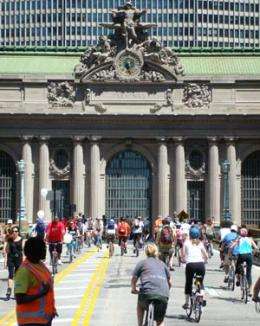Bicyclists at Grand Central Terminal in New York City. Photo by John Pucher.
(Medical Xpress) -- A new study led by a Rutgers researcher and published in the American Journal of Public Health reports a significant increase in walking between 2001 and 2009 in the United States, but only slight growth in cycling.
John Pucher, a professor at the Edward J. Bloustein School of Planning and Public Policy, headed the team from Rutgers, Virginia Tech and the University of Sydney that presented its findings, ”Walking and Cycling in the United States, 2001-2009: Evidence from the National Household Travel Surveys (NHTS).”
Using data from the 2001 and 2009 surveys to compute the frequency, duration and distance of walking and cycling per capita, the researchers found that the average American made 17 more walk trips in 2009 than in 2001, covering nine more miles per year, as compared with just two more bicycle trips and five more miles of cycling. Population-weighted person and trip files were merged to calculate prevalence of any walking and cycling, and of walking and cycling at least 30 minutes per day. While the prevalence of “any walking” in the population remained unchanged, walking at least 30 minutes per day increased from 7.2 percent to 8.0 percent. The prevalence of “any cycling” in the population remained at 1.7 percent, and the prevalence of “30 minute cycling” remained at 0.9 percent.
Changes in active travel between 2001 and 2009 were not equally distributed across population subgroups, Pucher explained. “Active travel declined for women, children and seniors, but increased among men, the middle-aged, the employed, the well-educated, and persons without a car,” he said. “That suggests important problems of social inequities in active travel.”
In designing the right mix of policies, it is important to target women, children and seniors, who are the most vulnerable pedestrians and cyclists and require special attention to protect them from the dangers of motor vehicle traffic, the authors concluded. “Improved infrastructure for walking and cycling should be combined with educational and promotional programs to help encourage the necessary behavior change toward a more active lifestyle,” the authors wrote.
The analysis confirmed the important role of public transport in encouraging active travel. With 90 percent of all public transport trips involving walk trips at both ends, policy packages for encouraging active travel should include safe and convenient pedestrian access to public transport stops. Cycling also has the potential to be an important access mode to public transport, the researchers found.
The article was published on May 5 by the American Journal of Public Health under “First Look”. It will appear in the October Supplement 2011 print issue of the journal.
More information: www.ajph.org/first_look.shtml
Provided by Rutgers University

.jpg)


















